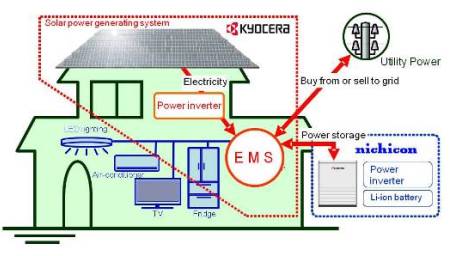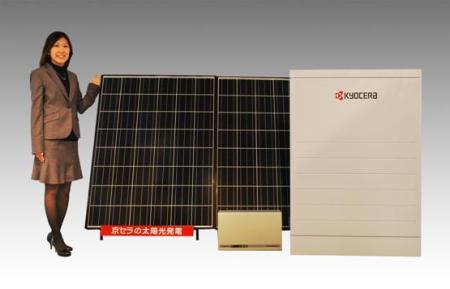Many of us talk about that fateful day when energy shortages will be a reality, and some have definitely experienced brownouts or blackouts during the 100-degree days of summer. Japan, however, had reality hit hard after the 2011 tsunami and nuclear plant meltdown. After mandatory power cuts, it’s not surprising the country has some extra fire in the belly to expand renewable energy and energy storage systems.
Quickly embracing this demand, Kyocera and Nichicon have combined forces to produce a residential home energy management system that integrates Kyocera’s solar panels and energy management system and Nichicon’s power storage unit into a system that the companies say provides reliable power for homes and balance for the utility grid.

While lowering the nation’s carbon footprint is part of Japan’s motivation for embracing renewable energy, addressing the issue of electricity supply instability is equally urgent, prompting investment in ways to store energy as well as produce it on-site. At a joint press conference with Nichicon, Kyocera President Tetsuo Kuba said the company will use its energy-management technology “to launch this new comprehensive system for optimizing residential energy use, and thus make a real contribution to preventing climate change.”
The energy system features Kyocera’s solar panels and energy management system along with Nichicon’s power storage unit that uses a lithium-ion battery produced by Samsung SDI. Like other companies investigating additional uses for their lithium-ion battery energy storage systems for electric vehicles, Nichicon and Kyocera just tweaked the wheel to develop a stationary use for the battery system.

As with most energy management systems, the system regulates energy fluctuations to optimize energy efficiency, and customers can choose from modes that either reduce their energy bill or give a guaranteed electricity supply. Unlike other solar power systems that will turn off during a blackout to allow for utility workers to safely fix the problem, Kyocera’s system automatically goes off the grid so the solar panels and storage keep generating and storing power.
The system’s cost has not yet been announced, but the Japanese government already has national subsidy and feed-in tariff programs for residential solar, and is starting a subsidy program for stationary lithium-ion battery energy storage systems in 2012. With these subsidies and emerging technologies, Kyocera estimates that by March, over one million homes will have solar power installed, and the number of installations will increase by 12 percent annually. Launching sales this summer, Kyocera hopes to sell 10,000 units in the first year.